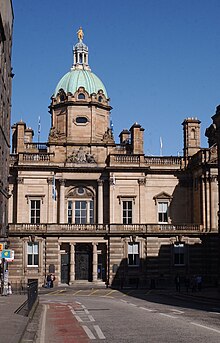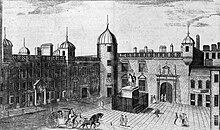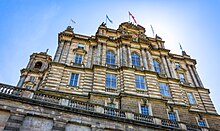 Headquarters building on The Mound | |
Native name | Banca na h-Alba (Gaelic) Bank o Scotland (Scots) |
|---|---|
| Company type | Public limited company |
| Industry | Financial services |
| Founded | The Governor and Company of the Bank of Scotland 17 July 1695 |
| Headquarters | Edinburgh, Scotland |
| Products | Banking and Insurance |
| Total assets | £359 billion (2016) [1] |
Number of employees | 20,000 |
| Parent | Lloyds Banking Group |
| Divisions | |
| Website | Bank of Scotland |
The Bank of Scotland plc (Scottish Gaelic: Banca na h-Alba) is a commercial and clearing bank based in Edinburgh, Scotland, and is part of the Lloyds Banking Group. The bank was established by the Parliament of Scotland in 1695 to develop Scotland's trade with other countries, and aimed to create a stable banking system in the Kingdom of Scotland.[2] The bank is the ninth oldest bank in continuous operation.[3]
With a history dating to the end of the 17th century, the Bank of Scotland was the first bank to have been established in Scotland, and,[4] it is the fifth-oldest extant bank in the United Kingdom (the Bank of England having been established one year earlier). It is the only commercial institution created by the Parliament of Scotland, when Scotland was an independent, sovereign state, to remain in existence. It was the first bank in Europe to successfully print its own banknotes,[5] and it continues to print its own sterling banknotes under legal arrangements that allow Scottish banks to issue currency.
In June 2006, the HBOS Group Reorganisation Act 2006 was passed by the Parliament of the United Kingdom, allowing the bank's structure to be simplified. As a result, The Governor and Company of the Bank of Scotland became Bank of Scotland plc on 17 September 2007.[6] Bank of Scotland has been a subsidiary of Lloyds Banking Group since 19 January 2009, when HBOS was acquired by Lloyds TSB.


The Governor and Company of the Bank of Scotland was established by an act of the Parliament of Scotland on 17 July 1695,[7] the Act for erecting a Bank in Scotland, opening for business in February 1696. Although established soon after the Bank of England (1694), the Bank of Scotland was a very different institution. Whereas the Bank of England was established specifically to finance defence spending by the English government, the Bank of Scotland was established by the Scottish government to support Scottish business, and was prohibited from lending to the government without parliamentary approval.[7]
The founding Act granted the bank a monopoly on public banking in Scotland for 21 years, permitted the bank's directors to raise a nominal capital of £1,200,000 pound Scots (£100,000 pound sterling), gave the proprietors (shareholders) limited liability, and in the final clause (repealed only in 1920) made all foreign-born proprietors naturalised Scotsmen "to all Intents and Purposes whatsoever".[7] John Holland, an Englishman, was one of the bank's founders.[7] Its first chief accountant was George Watson.[8]

The Bank of Scotland was suspected of Jacobite sympathies.[7] Its first rival, the Royal Bank of Scotland, was formed by royal charter in 1727.[7] This led to a period of great competition between the two banks as they tried to drive each other out of business.[7] Although the "Bank Wars" ended in around 1751,[7] competition soon arose from other sources, as other Scottish banks were founded throughout the country.[7] In response, the Bank of Scotland itself began to open branches throughout Scotland.
Following the Acts of Union in 1707, the bank supervised the reminting of the old Scottish coinage into Sterling. It was one of the first banks in Europe to print its own banknotes, and it continues to print its own sterling banknotes under legal arrangements that allow Scottish banks to issue currency.[9]
The bank also took the lead in establishing the security and stability of the entire Scottish banking system, which became more important after the insolvency of Alexander Fordyce and collapse of the Ayr Bank in 1772,[10] in the crisis following the collapse of the London house of Neal, James, Fordyce and Down.
Henry Dundas was Governor of the Bank of Scotland from 1790 to 1811. As well as governor, he was also Home Secretary in William Pitt the Younger's government. In 1792, Dundas was successful in passing the Slave Trade Bill in the House of Commons.[11]
The bank was housed in the southern (1588) section of the Gourlay house on Melbourne Place before being moved to the customised bank building on the Mound in 1805.[12]
The Western Bank collapsed in 1857, and the Bank of Scotland stepped in with the other Scottish banks to ensure that all the Western Bank's notes were paid.[13] The first branch in London opened in 1865.[14]
In the 1950s, the Bank of Scotland was involved in several mergers and acquisitions with different banks. In 1955, the Bank merged with the Union Bank of Scotland.[15] The Bank also expanded into consumer credit with the purchase of Chester-based, North West Securities (Later Capital Bank).[16] In 1971, the Bank agreed to merge with the British Linen Bank,[16] owned by Barclays Bank. The merger saw Barclays Bank acquire a 35% stake in the Bank of Scotland, a stake it retained until the 1990s.[17]
In 1959, the Bank of Scotland became the first bank in the UK to install a computer to process accounts centrally.[16] At 11:00 on 25 January 1985, the Bank of Scotland introduced HOBS (Home and Office Banking Services), an early example of remote access technology being made available to banking customers. This followed a small-scale service operated jointly with the Nottingham Building Society for two years but developed by the Bank of Scotland. The new HOBS service enabled customers to access their accounts directly on a television screen, using the Prestel telephone network.[18]
|
Main article: Bank of Scotland International |

The arrival of North Sea oil to Scotland in the 1970s allowed the Bank of Scotland to expand into the energy sector. The Bank later used this expertise in energy finance to expand internationally. The first international office opened in Houston, Texas, followed by more in the United States, Moscow and Singapore. In 1987, the Bank acquired Countrywide Bank[16] of New Zealand (later sold to Lloyds TSB in 1998). The Bank later expanded into the Australian market by acquiring the Perth-based Bank of Western Australia.[16]
A controversial period in the Bank's history was the attempt in 1999 to enter the United States retail banking market via a joint venture with evangelist Pat Robertson. The move was met with criticism from civil rights groups in the UK, owing to Robertson's controversial views on homosexuality. The Bank was forced to cancel the deal when Robertson described Scotland as a "dark land overrun by homosexuals".[19]
|
Main article: HBOS |

In the late 1990s, the UK financial sector market underwent a period of consolidation on a large scale. Many of the large building societies were demutualising and becoming banks in their own right or merging with existing banks. For instance Lloyds Bank and TSB Bank merged in 1995 to create Lloyds TSB.[20] In 1999, the Bank of Scotland made a takeover bid for National Westminster Bank.[21] Since the Bank of Scotland was significantly smaller than the English-based NatWest, the move was seen as an audacious and risky move. However, The Royal Bank of Scotland tabled a rival offer, and a bitter takeover battle ensued, with the Royal Bank the victor.[22]
The Bank of Scotland was now the centre of other merger opportunities. A proposal to merge with the Abbey National was explored, but later rejected.[23] In 2001, the Bank of Scotland and the Halifax agreed a merger to form HBOS ("Halifax Bank of Scotland").[24]
In 2006, HBOS secured the passing of the HBOS Group Reorganisation Act 2006, a private Act of Parliament that would allow the group to operate within a simplified structure. The Act allowed HBOS to make the Governor and Company of the Bank of Scotland a public limited company, Bank of Scotland plc, which became the principal banking subsidiary of HBOS. Halifax plc and Capital Bank plc transferred their undertakings to Bank of Scotland plc, and although the Halifax brand name was retained, Halifax then began to operate under the latter company's UK banking licence.[25] Capital Bank branding was phased out.
The provisions in the Act were implemented on 17 September 2007.[26]
In 2008, HBOS Group agreed to be taken over by Lloyds TSB Group during the Great Recession.[27]
Bank of Scotland sponsored the Scottish Premier League from its inception in 1998 to season 2006/2007 when it declined to renew the deal in favour of investing in grassroots sport instead. They also sponsored Scottish Athletics for a number of years.
Henry Dundas was Governor of the Bank of Scotland from 1790 to 1811. As well as governor, he was also Home Secretary in William Pitt the Younger's government. In 1792 Dundas was successful in passing the Slave Trade Bill in the House of Commons.[28]
|
See also: Banknotes of Scotland |
Although the Bank of Scotland today is not a central bank, it retains the right (along with two other Scottish commercial banks) to issue pound sterling banknotes to this day. These notes are equal in value to notes issued by the Bank of England, the central bank of the United Kingdom.
Along with the Bank of England, the Bank of Scotland was one of the first European banks to issue paper currency redeemable for cash on demand (which was an extremely useful facility given the poor state of the Scottish coinage at the end of the 17th century) on a sustainable basis after the earlier failed attempt of the Swedish Stockholms Banco in 1661–64. Following the Acts of Union in 1707, the bank supervised the reminting of the old Scottish coinage into Sterling. Up until the middle of the 19th century, privately owned banks in Great Britain and Ireland were permitted to issue their own banknotes, and money issued by provincial Scottish,[29] English, Welsh and Irish banking companies circulated freely as a means of payment.[30]
In 1826, there was outrage in Scotland at the attempt of the United Kingdom Parliament to prevent the production of banknotes of less than five pounds face value. Sir Walter Scott wrote a series of letters to the Edinburgh Weekly Journal under the pseudonym "Malachi Malagrowther", which provoked such a response that the government was forced to relent and allow the Scottish banks to continue printing £1 notes.[31]

Bank of Scotland's previous note issue was in 1995, known as the Tercentenary Series as they were issued in the year of the three hundredth anniversary of the foundation of the bank. Each denomination features Sir Walter Scott on the front, and on the back are representations of industries that Scotland excels in:
These notes are no longer in circulation.

Bank of Scotland began issuing a new series of banknotes in the Autumn of 2007, which feature the common theme of Scottish bridges.[32] It will take at least three years for the current issue of Bank of Scotland notes to be phased out of circulation. In keeping with the bank's tradition, the front of the notes depict an image of Sir Walter Scott; the image on the 2007 series is based on the portrait of Scott painted by Henry Raeburn.[33]
Some new security features have also been added to the new design. These include a metallic security thread embedded in every banknote, which contains the numerical value of the note and the note's bridge image. A new hologram and foil patch has been introduced on the front of the £20, £50 and £100 notes, which features the Bank of Scotland logo and the numerical value of the note.
On 1 March 2018 the Bank of Scotland decided to withdraw all of its paper £5 and £10 notes, and fully replace them with its polymer equivalents (see below).[34]
Bank of Scotland began issuing new banknotes on polymer in 2016, beginning with the £5 note. The main theme of the bridges of Scotland are kept for this series, but have been redesigned to incorporate additional design features. The portrait of Sir Walter Scott by Henry Raeburn is the same as the 2007 issues, but have been shifted from the centre to the right side of the notes. The bank's headquarters, "The Mound" is featured at the centre of the note. The size of the notes for this series is also reduced.[35][36][37]
Associated brands include: